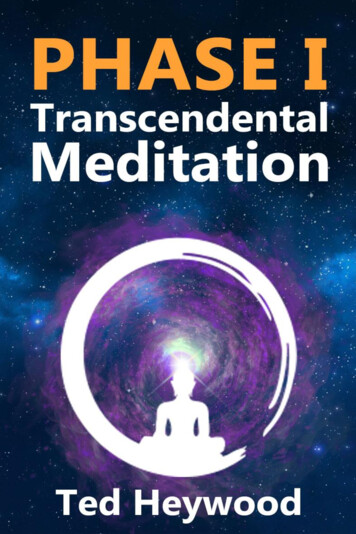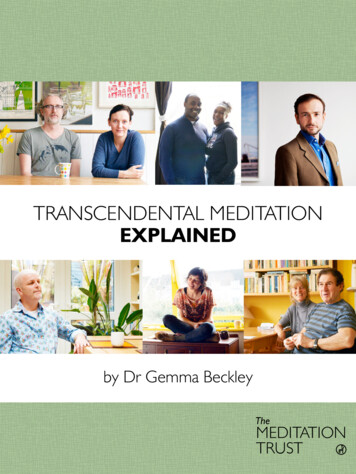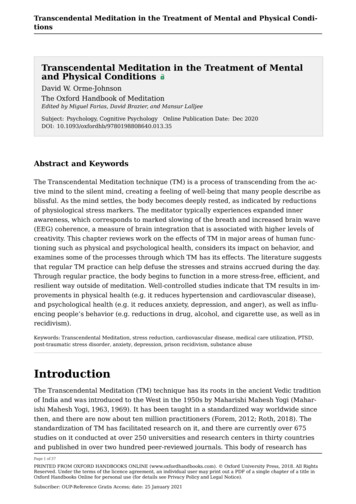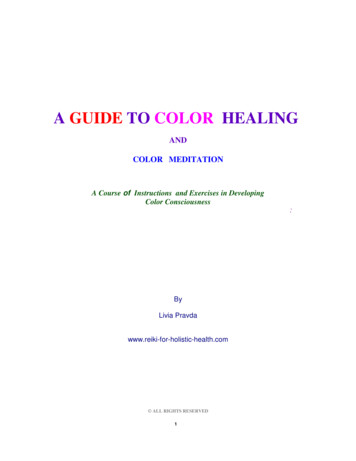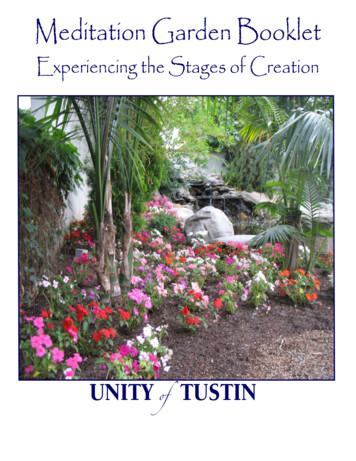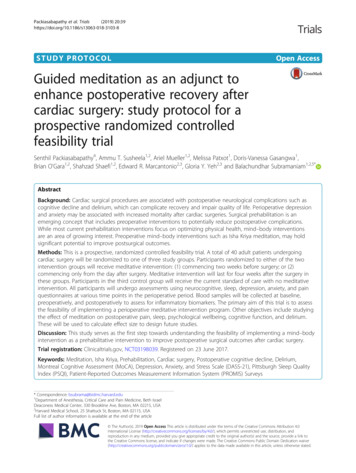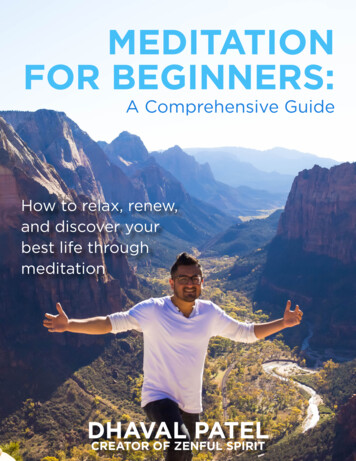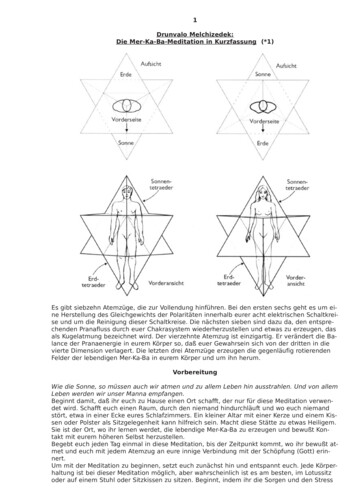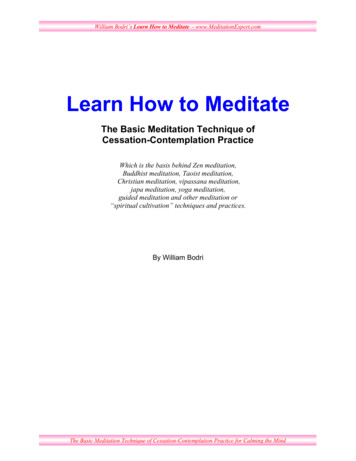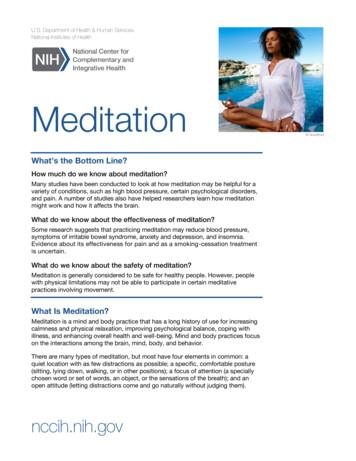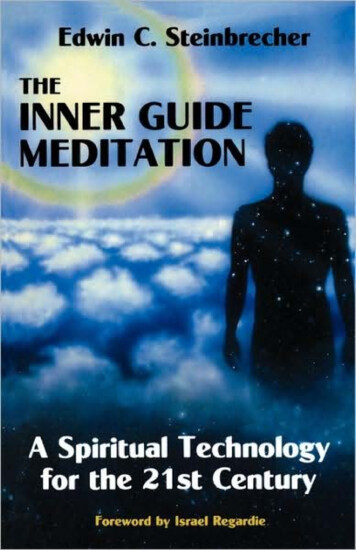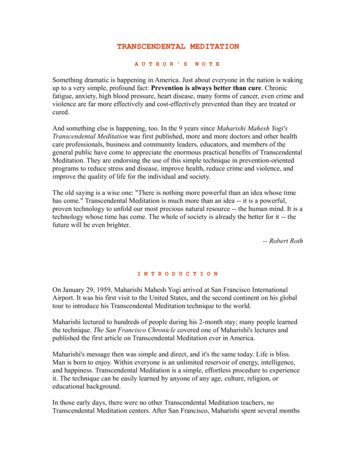
Transcription
TRANSCENDENTAL MEDITATIONA U T H O R ' SN O T ESomething dramatic is happening in America. Just about everyone in the nation is wakingup to a very simple, profound fact: Prevention is always better than cure. Chronicfatigue, anxiety, high blood pressure, heart disease, many forms of cancer, even crime andviolence are far more effectively and cost-effectively prevented than they are treated orcured.And something else is happening, too. In the 9 years since Maharishi Mahesh Yogi'sTranscendental Meditation was first published, more and more doctors and other healthcare professionals, business and community leaders, educators, and members of thegeneral public have come to appreciate the enormous practical benefits of TranscendentalMeditation. They are endorsing the use of this simple technique in prevention-orientedprograms to reduce stress and disease, improve health, reduce crime and violence, andimprove the quality of life for the individual and society.The old saying is a wise one: "There is nothing more powerful than an idea whose timehas come." Transcendental Meditation is much more than an idea -- it is a powerful,proven technology to unfold our most precious natural resource -- the human mind. It is atechnology whose time has come. The whole of society is already the better for it -- thefuture will be even brighter.-- Robert RothI N T R O D U C T I O NOn January 29, 1959, Maharishi Mahesh Yogi arrived at San Francisco InternationalAirport. It was his first visit to the United States, and the second continent on his globaltour to introduce his Transcendental Meditation technique to the world.Maharishi lectured to hundreds of people during his 2-month stay; many people learnedthe technique. The San Francisco Chronicle covered one of Maharishi's lectures andpublished the first article on Transcendental Meditation ever in America.Maharishi's message then was simple and direct, and it's the same today. Life is bliss.Man is born to enjoy. Within everyone is an unlimited reservoir of energy, intelligence,and happiness. Transcendental Meditation is a simple, effortless procedure to experienceit. The technique can be easily learned by anyone of any age, culture, religion, oreducational background.In those early days, there were no other Transcendental Meditation teachers, noTranscendental Meditation centers. After San Francisco, Maharishi spent several months
in Los Angeles, then traveled on to New York. From New York, Maharishi went toEngland, Germany, Greece, and on around the world.The Transcendental Meditation movement started simply and grew steadily. Thensuddenly, with the first published scientific research on the technique, TranscendentalMeditation gained worldwide recognition.The first study on Transcendental Meditation was conducted at the University ofCalifornia at Los Angeles in 1968 by physiologist Robert Keith Wallace. His thesis, "ThePhysiological Effects of Transcendental Meditation: A Proposed Fourth Major State ofConsciousness," earned him his Ph.D., and his findings were published in the journalsScience and Scientific American. This also inspired a huge upsurge of research into theeffects of Transcendental Meditation.By 1975 Transcendental Meditation was a household word.And today? More than four million people worldwide -- including more than one millionpeople in the United States -- from every profession, age, educational background, andreligion practice Transcendental Meditation. And the number keeps growing.The technique has been learned by over 6,000 medical doctors in the U.S. and by tens ofthousands of executives, managers, and employees of large corporations and smallbusinesses throughout the U.S. and the world.Homemakers practice Transcendental Meditation. So do attorneys, computerprogrammers, teachers, students, sales clerks, clergy, athletes, factory workers, architects,airline pilots, electricians, chefs, and artists.Why? Transcendental Meditation is easy to learn. Anyone can practice it. And it works.During the past 25 years, more than 500 scientific research studies have been conductedon the effects of the Transcendental Meditation technique at 210 independent universitiesand research institutions in 33 countries. The studies -- many of which have beenpublished in leading scientific journals -- have shown that the Transcendental Meditationprogram: Reduces stressIncreases creativity and intelligenceImproves memory and learning abilityIncreases energyIncreases inner calmReduces insomniaIncreases happiness and self-esteemReduces anxiety and depressionImproves relationshipsImproves health
Promotes a younger biological age.Since Maharishi first began teaching the Transcendental Meditation technique over 36years ago, modern science has made major breakthroughs in understanding how naturefunctions. Recently, scientists have glimpsed the deepest level of nature's functioning -the unified field of natural law -- which is the source of the unlimited creative potentialdisplayed throughout the universe.As we'll see in this book, the unlimited potential found deep within human consciousnessand the unlimited potential found at the level of the unified field are not different; theyare the same.Transcendental Meditation is a simple, effective technique that enlivens the unlimitedpotential of life from its source in the unified field. It enriches all areas of life, just aswatering the root of a plant brings nourishment to all parts of the plant.This book has been written to provide you with a brief and complete introduction to theTranscendental Meditation program. It is an introduction to the technique that can changeyour life for good.I hope you enjoy it.C H A P T E R1Transcendental Meditation at a GlanceA Harvard graduate student asked his instructor, Ronald David, M.D., about meditation.What was it? What did it do? Dr. David, Lecturer in Public Policy at the John F. KennedySchool of Government, offered to find out. He called the Transcendental MeditationCenter in Cambridge, and the next week a speaker addressed Dr. David's class.Fascinated, six students, along with Dr. David, started the technique.It's now 18 months later, 8:00 a.m. on a Tuesday -- one of the busiest days of the week forDr. David. He sits in his office, notes for today's lectures piled on his desk. But before hestarts to review them -- and before his office turns busy -- he turns off the ringer on histelephone, closes his eyes, and begins his morning practice of Transcendental Meditation." I finish meditating and I start the day feeling alert, creative, energized, and much moreorganized," Dr. David says.Later that morning, after going over his notes with a colleague, Dr. David, a notedpediatrician-turned- policy analyst, will lecture to 42 graduate students on "Risk andResilience in Childhood: Implications for Public Policy." After lunch, he will make finalpreparations for, and then teach, a 3-hour afternoon seminar.
"At the end of what has normally been a hectic pace and before I get on the train to gohome, I close the door to my office, again turn off the ringer on the telephone, andmeditate. I wind down from the tension of the day; it leaves me completely refreshed andalert for the train ride back, so I can do something I enjoy, such as read a book, ratherthan just fall asleep."As a health policy analyst, Dr. David sees significant applications for TranscendentalMeditation." We have focused too long and too exclusively on the medical model of management,"Dr. David says. " I am impressed with the emerging data on the role of TranscendentalMeditation in the treatment of intractable hypertension, reduction of recidivism in prisoninmates, and recovery from drug addiction -- particularly among African Americans." For me Transcendental Meditation is much more profound than simply a physiologicalway of relaxing. It's a way of becoming whole, of experiencing our own deep innerconnectedness as human beings. That experience gives a far greater capacity for healthand healing."What exactly is Transcendental Meditation?And what is it not?What are the benefits? How does it work?The first thing to know about the Transcendental Meditation program of MaharishiMahesh Yogi is that it's easy to learn and enjoyable to practice.Second, scientific research shows that the benefits of Transcendental Meditation can beseen immediately and accumulate over time.Third, it's simple to understand.What Transcendental Meditation IsTranscendental Meditation is a simple, natural, effortless, easily-learned mental techniquepracticed for 15 to 20 minutes twice daily, sitting comfortably with the eyes closed.To elaborate: Simple -- Transcendental Meditation is not difficult or complicated; it is a simpleprocedure.Natural -- there is no manipulation or suggestion, such as in hypnosis.
Effortless -- Transcendental Meditation is easy to practice and requires no abilityto concentrate or control the mind.Easily learned -- anyone beginning from age 10 can learn TranscendentalMeditation easily.Mental technique -- it requires no physical exercises, special postures, orprocedures.Practiced for 15 to 20 minutes twice daily -- Transcendental Meditation ispracticed for 15 to 20 minutes: once in the morning before breakfast, to start theday with alertness and energy, and once again in the afternoon before dinner, toeliminate the accumulated stress of the day and as a basis for an enjoyableevening and a good night's sleep.Sitting comfortably -- no awkward or cramped positions are necessary topractice Transcendental Meditation. You can practice the technique anywhere -- inyour office after work, riding the subway, sitting in a plane, or even in your carparked at a highway rest stop. But it is usually practiced in the comfort of yourown home.What Happens During Transcendental MeditationDuring Transcendental Meditation the mind settles down to a silent, yet fully awake, stateof awareness -- pure consciousness. At the same time the body gains a unique andprofound state of rest and relaxation.To understand the experience of the mind and body settling down during TranscendentalMeditation, we'll take two common occurrences.Excited mind: It's Friday, 2:00 p.m. It's been a busy day and a long week. You're late foran appointment. You race to your car only to realize that you've forgotten your keys. Youfind your keys, and then you have to battle traffic and road construction before finallymaking it to your appointment -- only to discover that you've left behind some importantpapers. Your mind is speeding, and your heart is pounding.Settled mind: It's Sunday afternoon and you're heading home from a long weekendvacation, rested and refreshed. You feel contented, relaxed, happy. Your mind is alert,calm, clear. You begin to think of new ways to make things better at work and at home -good, practical ideas.Both of these experiences -- of greater and of lesser excitation of mind and body -- arealready very familiar to us.Now what does Transcendental Meditation do?Transcendental Meditation is a systematic technique that allows mental activity to settledown to a silent state of awareness where the mind is calm, collected, yet fully expanded,fully awake.
This state is the simplest form of human awareness. It is pure consciousness, a state of"self-referral" awareness open only to itself -- open to its own full potential. And as we'llsee in the next chapter, it is the unified field of natural law, which modern physicsdescribes as the source of the infinite creativity and intelligence of nature.This settled state is completely natural to the mind. It has always been there. It was there10 years ago, it's there right now, and it'll be there tomorrow. Only it has been lost fromexperience, lost from use, because of the constant noise and pressures and excitations ofdaily life.Transcendental Meditation allows the mind to experience pure consciousness easily,effortlessly, and enjoyably. At the same time, extensive scientific research has shown thatwhile the mind settles down during Transcendental Meditation, the body gains a state ofprofound rest and relaxation that is far deeper than any other technique of meditation orrelaxation produces.Benefits of Transcendental MeditationWhat are the benefits of this experience?Pure consciousness is the source of the unlimited creativity and intelligence of the mind.Research has shown that the twice daily experience of pure consciousness duringTranscendental Meditation makes the mind more alert, creative, and intelligentthroughout the day.And the deep rest provided by Transcendental Meditation eliminates the build-up ofstress and tension; improves health; and provides the basis for more dynamic, productive,and satisfying activity.Not All Rest Is EqualRest eliminates stress. The deeper the rest, the better. The rest gained during a night'ssleep is sufficient to eliminate some of the stress and fatigue that comes from a full day ofactivity. But obviously a night's sleep, no matter how deep, isn't enough. We may feelbetter the next morning, but all too often we don't feel completely refreshed, completelyfree from the fatigue of the day -- and days -- before.So we may exercise to help cope with stress -- play tennis, work out at the gym, take anevening walk -- or listen to music, read a book, knit a sweater, or go on a fishing trip.But something is missing. Despite our best efforts, stress clings to the nervous system andbuilds up day after day, year after year. Butterflies in the stomach from pre-exam nervesat age 16 can turn into stomach ulcers, high blood pressure, or premature aging, at age 40-- all from too many years of too much worry.What is missing? Very, very deep rest.
Recreation or a vacation may be relaxing, but they don't provide the depth of restnecessary to eliminate accumulated stress. Because of this, the benefits are short-lived.(Recall your first day back at work after a week-long vacation. Within a few hours it feelslike you nev
Transcendental Meditation is a systematic technique that allows mental activity to settle down to a silent state of awareness where the mind is calm, collected, yet fully expanded, fully awake. This state is the simplest form of human awareness. It is pure consciousness, a state of "self-referral" awareness open only to itself -- open to its own full potential. And as we'll see in the next .
